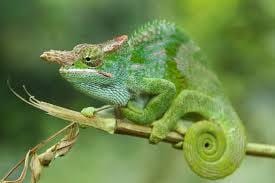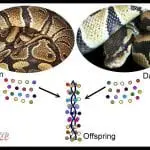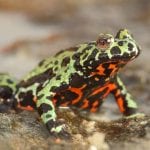Iguanids are herbivores, and they have nasal salt glands. These glands excrete excess substance, sodium chloride when they sneeze. The clear fluid from sneezing eventually dries into a white powder. But for chameleons, they don’t perform such activity, so if you notice a white substance in your chameleon’s nose, it must be a different reason.
Chameleons have a natural white substance on their noses. You probably have noticed this characteristic on your pet. But, what are the facts behind this physical quality of chameleons? That’s what you’ll be learning in this post.
Characteristics of Chameleons
Chameleons (family Chamaeleonidae) belong to any of a primarily arboreal (tree-dwelling). These reptiles are part of the iguana suborder. And these colorful lizards are known as one of the few animals that can change their skin color. But, it is a misconception that chameleons change their color according to the surroundings.
Chromatophores are specialized color pigment cells under the skin, and some chameleon species change their skin color and creating combined patterns of pink, red, blue, orange, green, black, brown, yellow, and purple. This lizard beautiful and interesting, but it is challenging to keep in captivity.
Good to Know Facts About Chameleons
- Chameleons bites are not toxic or harmful to humans, but it is painful.
- Handling chameleons can cause chronic low-level stress, which can lead to an unhealthy condition.
- Chameleons in the wild do not eat dry or dusted prey items. Chameleon should eat as many different kinds of insects as possible but within a certain menu.
- Chameleons eat crickets, grasshoppers, flies, tomato hornworms, silkworms, waxworms, mealworms, and cockroaches.
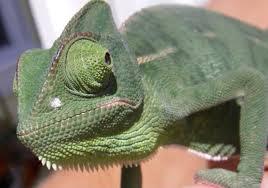
White Substance on Chameleons Nose
Humans relieve excess salt through sweat and urine. Unlike humans, Chameleons can’t sweat, so they have to relieve it in another way. Chameleons do this by forcing this excess through their gland that they have around their nose.
The gland allows the conservation of water and excretes excess salt. Salt is excreted by sneezing and borrowing. This chameleon’s behavior is beyond is usual, normal, and proper to the other reptiles. The gland is also used to relieve excess chloride and bicarbonate. In captive chameleons, excess salt is come by the salt, which added to their reptile supplement powder or some chameleons excess their salt is caused by watering them with tap water in hard water areas.
Here are the good-to-know facts about chameleons’ white substance in their noses:
- Chameleon’s nose remains those white crust, and those what you see around their nose is when the salt excreted through the gland. The excess salt that your chameleons are getting rid of is natural. Nothing to worry about it. Maybe some of you have mistaken and bothered about the white crust. But this white crust on Chameleons nose is just simply their skin.
- Chameleons and other lizards sneeze to relieve or to blow the salt cake out of their nostrils, and because they do not unite, they need another way to get rid of the access salt that doesn’t come out in the Chameleons urinates. It is naturally amazing because they get big, and they can blow a large amount of salt.
- The white substance is not an excess of calcium caused as a result of the over-supplementation of this mineral at feeding times. And Chameleons need the calcium for stronger bones but do not overdose them. The white crust won’t be caused by too much calcium because Chameleons don’t deal with calcium in this way.
- Chameleons also need a variety of vitamins and minerals to grow, and they can develop successfully. In the wild, they will get much of this by eating a variety of insects. In captivity, the number of insects is limited, so supplementation needs to ensure these Chameleons’ needs.
- If you supply your Chameleon too much, it will get those white crust because your chameleons have to give them out of their body, and it’s because they had it enough. Your chameleon won’t have trouble breathing through its nose while having a white crust, and they are unlikely to be bothered much because of it.
- In captive chameleons, excessive salt is caused by watering them with tap water in a hard water area. Do you live in an area with hard water (where there are plenty of dissolved water minerals)? It could be possible that a white substance collects on the chameleon’s face with the evaporation of hard water. Experts highly recommend you to switch to bottled spring water. While it may result in the accumulation of minerals over time, it would help treat the white substance in your chameleon’s nose.
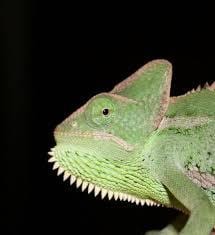
How to Prevent and Treat the White Substance on Chameleons Nose
- White Crust will either fall off on its own in time, but it is better to wash your Chameleon regular misting more frequently, and turning on your fogger more often can help.
- There is an easy way to tell if it is salt crystals or skin. Try and look your Chameleons nose when they are relaxing under the heat lamp. In that way, you should be able to get a better look at the color of the substance in the light.
It is most likely to the skin when if it is pure white and not crusty. Either from a shed or inside its nostrils. If it is salt excretion when if it slightly yellow quality. - The cause of white crust is when your Chameleons getting rid of excess salt. You should start by reducing the amount of supplement powder you sprinkle on your Chameleons feeder insects to prevent excessive salt build-up in the future.
- If your Chameleon is in the waterfall that is full of bacteria, get them out of immediately.
- If your Chameleons have a white crust on their nose, it is better to let the skin shed in its own time only.
- Chameleons easily stress, so if they have the white crust to their nose, do not handle them anymore and do not apply too much pressure in attempting to remove the white substance.
- If you don’t want your Chameleons to become stressed on the presence of white crust of their nose, you can buy products to assist in shedding. But never try to pull their skin off with your fingers. It will be painful for you, Chameleon.
- If you think that the white crust of your Chameleons is a result of an injury, then let them until they heal. But if you have concerns about the wound and it has become worse, take your chameleons to your local reptile vet. If your Chameleons build-up of white substance is a new symptom, then chameleons need to be examined by a qualified herp vet.
Chameleons, by nature, can easily become stressed. So if you think that the white crust bothered them, then you need to know how you will treat and prevent them. But if this article cold does not help your chameleons white crust on their nose, you should bring his or her to the reptile veterinarian.
Asking Veterinarian’s Help
If the accumulation of the white substance is just a new sign you’ve observed in your chameleon, then have your lizard checked by a qualified veterinarian. You can temporarily use lukewarm bottled spring water for removing the white substance. Also, using a cotton-tipped applicator can dislodge the material gently. However, if you’re planning to take your pet chameleon to see a veterinarian, don’t clean off your chameleon’s face so that the vet can observe what’s going on.
Most of the reptile veterinary treat more chameleons than any other type of reptile. Chameleons owners come into these reptile veterinary clinics will all sorts of diseases and problems, dehydration, food overdose, eye problems, metabolic bone disease, and more.
Video Source: Youtube
This video is about how to supplement your Chameleon correctly. It would help you like a chameleon owner to feed them well and not to overdose them, especially giving lots of calcium that can get them white substance on their nose.
Conclusion
Some do not recommend chameleons for the first time reptile keeps. Too many Chameleons are amazing lizards die in captivity each year because the owners could not raise the challenge or simply they did not become aware and knows how. If you are a first-timer in having a chameleon pet, you need to research or to study how you will take care of them.
Now that you have learned the possible causes of why the nose of a chameleon builds a white substance over time, you’ll know what to do if it happens to your pet. Chameleons are sensitive, and they have a special skill that can make excess salt through the white crust of their nose. Make sure to assess your pet regularly and bring it to the veterinarian if you find this sign just new to your chameleon so proper intervention will be given. In this way, you’ll make your pet happy and healthy.

